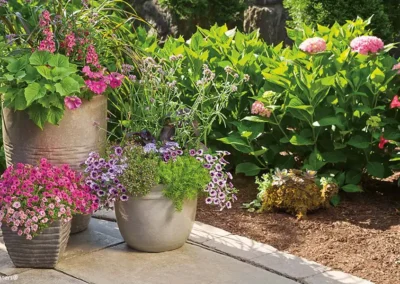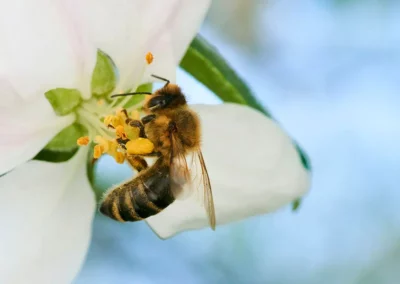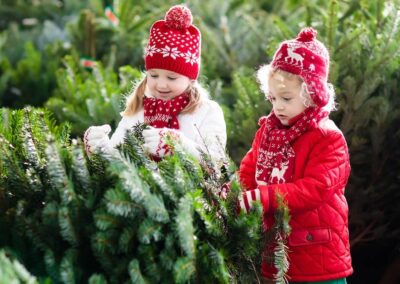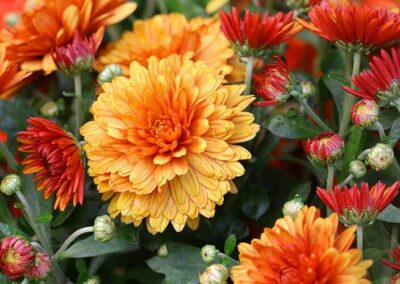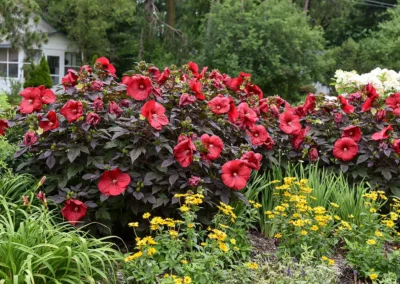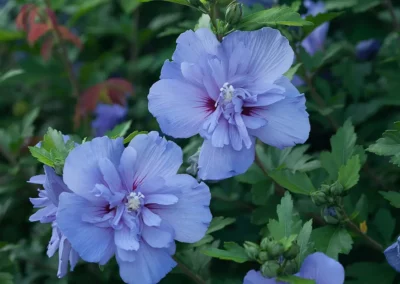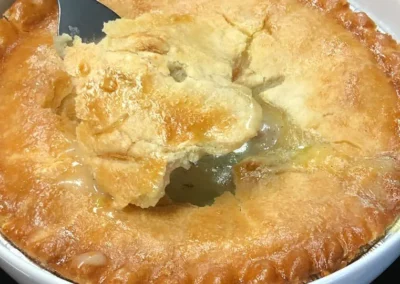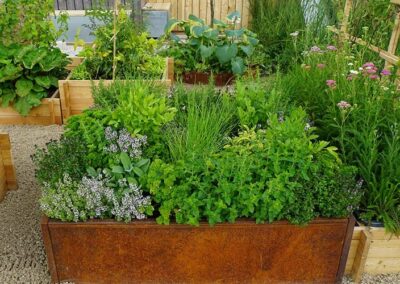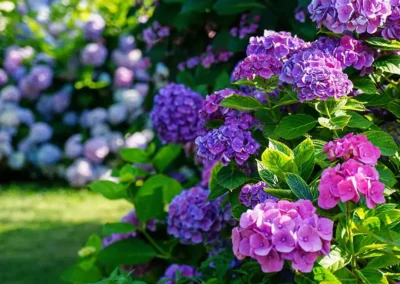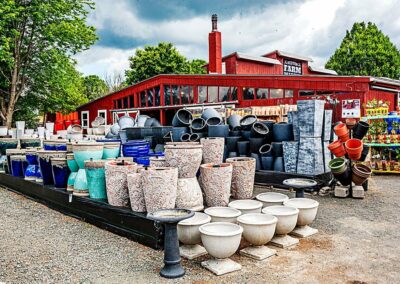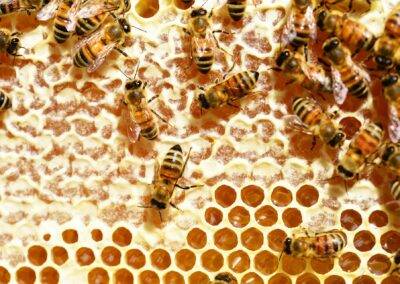Have you ever wondered why particular plants attract particular pollinators? 🌸 It’s like nature’s very own matchmaking service, ensuring that each plant and their pollinator partner thrives. Take a look at some of these plant-pollinator pairings so you can cultivate your garden so it becomes a buzzing, fluttering paradise.
Whether you’re looking to attract bees, butterflies, birds, or even bats, these plant suggestions can get you started.
First, What is Pollination?
Get ready to get some learnin’ on… Pollination is the transfer of pollen from the male parts (anthers) of a flower to the female parts (stigma) of the same flower OR a different one.
This process leads to fertilization, allowing plants to produce seeds and fruit. While some plants are self-pollinating, most rely on external help—pollinators—to move the pollen for them.
Bee-Friendly Beauties
Bees are some of the most efficient pollinators around, and they love flowers that are rich in nectar and pollen. Here are a few plants that are sure to attract these busy little helpers:

Lavender (Lavandula spp.)
Why Bees Love It: Bees are drawn to the sweet, calming fragrance and the abundant nectar. Lavender’s purple blooms are simply a beacon for bees.
Planting Tips: Lavender thrives in full sun and well-drained soil. It’s also drought tolerant, making it a low-maintenance addition to your garden.

Sunflowers (Helianthus annuus)
Why Bees Love It: These sunny giants offer a large landing platform and a wealth of pollen.
Planting Tips: Sunflowers grow best in full sun and can handle a variety of soil types. If growing from seed, they prefer direct sowing. They range in sizes — you may want to secure the tallest ones as they’re susceptible to leaning and breaking in heavy wind and rain.

Catmint (Nepeta spp.)
Why Bees Love It: Catmint is typically one of the first perennials to bloom, offering long-lasting flower spikes that are full of nectar and pollen.
Planting Tips: Catmint flowers best in full sun to partial shade, with average, well-draining soil. These hardy plants are even heat and drought tolerant, making them excellent plants for dry garden areas. *Catmint is also a great substitute for lavender, if you’re looking for one.
Butterfly Delights
Butterflies bring a touch of magic to any garden. They’re particularly fond of brightly colored flowers and those with flat surfaces that provide a landing pad. Here are some top picks to attract these winged beauties:

Butterfly Bush (Buddleja davidii)
Why Butterflies Love It: The elongated clusters of tiny flowers are perfect for butterflies to perch on while they sip nectar.
Planting Tips: Butterfly bushes prefer full sun and well-drained soil. Prune them in early spring to encourage new growth and more flowers.

Milkweed (Asclepias spp.)
Why Butterflies Love It: Milkweed is a vital host plant for monarch butterflies. The caterpillars feed on the leaves, and the flowers provide nectar for adults. Be sure you plant LOTS AND LOTS of this as the caterpillars go through it very fast. And the last thing you want is to run out of it when the babies are hungry!
Planting Tips: Plant milkweed in full sun. It’s a hardy plant that can grow in a variety of soil conditions, including dry, sandy areas.

Lantana (Lantana camara)
Why Butterflies Love It: Lantana provides sweet nectar for food, attractive scent, bright color, and the overall flower form is easy to land upon. Bonus, it’s the host plant for the painted lady butterfly caterpillar.
Planting Tips: Lantana needs full sun (at least six hours a day!) for maximum flowering. Be sure to water it thoroughly; it prefers moist, well-draining soil. If it’s a perennial for you, prune it after it flowers to encourage future blooms on bushier branches.
Hummingbird Favorites
Hummingbirds are attracted to bright, tubular flowers that allow them to hover while they feed. Here are a couple of plants that will have these tiny birds zipping around your garden:

Bee Balm (Monarda didyma)
Why Hummingbirds Love It: The vibrant red, pink, or purple tubular flowers are a perfect fit for hummingbirds’ long beaks and tongues.
Planting Tips: Bee balm grows well in full sun to partial shade and moist, well-drained soil. It can spread, so give it some room to grow.

Salvia (perennial)
Why Hummingbirds Love It: Another colorful tubular flower with sugary nectar, perfect for hummingbirds. Did you know hummingbirds can taste sweets, unlike most birds?
Planting Tips: It prefers well-drained soil and thrives in full sun as well as part shade. After the fall’s first freeze, the stalks of the plants will turn brown. Wait until late spring to remove the brown stalks, allowing the old stems to protect the plant from freezes and provide a habitat for overwintering insects.

Foxglove Beardtongue (Penstemon digitalis)
Why Hummingbirds Love It: Another tubular flower, the Foxglove Beardtongue’s bloom shape makes it easy for hummingbirds to sip from, but difficult for other insects. Hummers are especially attracted to the flashier colors such as red and orange.
Planting Tips: Full sun and well-draining soil are key for these perennials. Water them as needed, but hold the fertilizer; rich, fertile soil will actually decrease flowering.
Moth Magnets
Moths, especially nocturnal ones, are often overlooked as pollinators. They’re drawn to pale or white flowers that open in the evening. Here’s a plant that’s sure to attract these nighttime visitors:

Evening Primrose (Oenothera biennis)
Why Moths Love It: The fragrant yellow flowers open in the evening, making them a perfect snack for nocturnal moths.
Planting Tips: Evening primrose is easy to grow in full sun and well-drained soil. Plus it can tolerate poor soil and drought conditions.
Be a Plant and Pollinator Matchmaker
Creating a pollinator-friendly garden is a wonderful way to support local wildlife while enjoying a vibrant and dynamic outdoor space. By selecting plants that attract specific pollinators, you can ensure that your garden becomes a hotspot of activity. (And your friends at Reston Farm Garden Market can help you find the plants you need!) So, whether you’re a fan of bees, butterflies, hummingbirds, or moths, there’s a plant out there waiting to bring them into your garden.
Other Articles on Pollinators:
- The Power of Pollination: Why It Matters and How You Can Help
- How to Create a Pollinator Paradise in Zone 7










